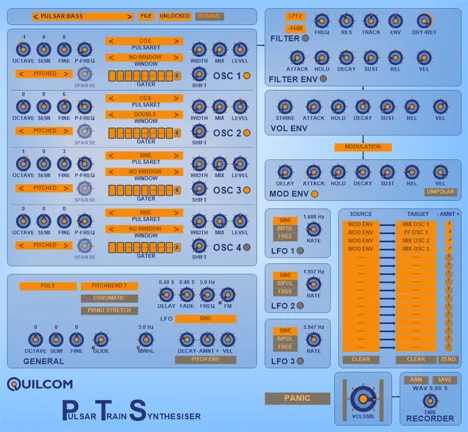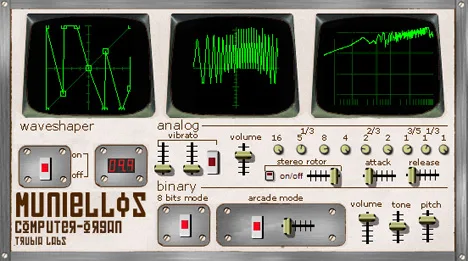Immerse yourself in the depths of sonic alchemy with the PTS plugin from the talented developer Quilcom. In an era where digital technologies unlock boundless possibilities for music production, instruments based on unique and historically significant synthesis techniques become true gems for sound experimenters. PTS is just such an instrument, offering a fresh perspective on sound creation, departing from traditional methods.
Pulsar Train Synthesis: A Sound Technique from the Past, Relevant Today
At the heart of the PTS plugin lies the concept of Pulsar Train Synthesis, a granular synthesis technique whose pioneering research was conducted by Curtis Roads in 1979. Imagine a sound created not from sustained waves, but from a sequence of extremely short pulses or “pulsars.” The frequency at which these pulsars are played, their density, shape, and interaction with each other form the final timbre. This is similar to rapid flashes of light that, at a certain frequency, merge for our eyes into a solid glow, but with sound – rapid “grains” merge in perception into a complex tone or texture. PTS masterfully implements this approach, allowing you to explore a wide range of sounds: from dense, almost physical buzzes and hums to transparent, airy textures and complex, moving soundscapes. This technique is particularly interesting for creating unique synthesizer sounds, unconventional percussion elements, and atmospheric effects that are difficult to obtain through other methods.
Inspiration, Functionality, and Creative Possibilities
The creation of PTS was significantly influenced by the innovative Nuklear simulator from Hamburg Audio, known for its deep dive into unconventional synthesis methods. Quilcom PTS continues this tradition, providing users with an accessible yet powerful tool for working with pulsar synthesis. The plugin interface is designed to facilitate experimentation and quick finding of the desired sound, allowing control over key parameters:
- The number and density of pulsars in the “train.”
- The shape and duration of an individual pulsar.
- Modulation parameters for dynamically changing the sound over time.
- Envelope shaping and filter application capabilities for further timbre sculpting.
Using PTS opens up new horizons for musicians working in electronic music genres (Ambient, Techno, Experimental, IDM), sound designers for film, games, and multimedia, as well as anyone who wants to expand their sound palette. The plugin allows you to create both clearly defined melodic and rhythmic elements, as well as abstract, evolving sound textures that can form the basis of a composition or complement it with unique layers.
Additional Resources for a Quick Start
The developer has made sure that your acquaintance with PTS is as productive as possible. The plugin package includes:
- Preset Banks from Manfred Plumer: Two specially created banks demonstrating the potential of PTS. They serve not only as ready-made sounds but also as educational material, showing how different settings affect the final result.
- Comprehensive User Guide: A detailed description of each interface element and function of the plugin, which will help you master all the subtleties of pulsar synthesis within PTS.
- Information about Pulsar Train Synthesis: Additional materials that delve into the theory and history of this Fascinating technique, providing context and a deeper understanding of the plugin’s operating principles.
Quilcom PTS is available in VST format for 32-bit and 64-bit versions of the Windows operating system. This ensures broad compatibility with most modern digital audio workstations. If you’re ready to go beyond the usual synthesis and add unique, unexpected timbres to your music or sound projects, PTS from Quilcom will become a valuable and inspiring tool in your arsenal. Try it today and hear the future of sound rooted in the innovations of the past!



